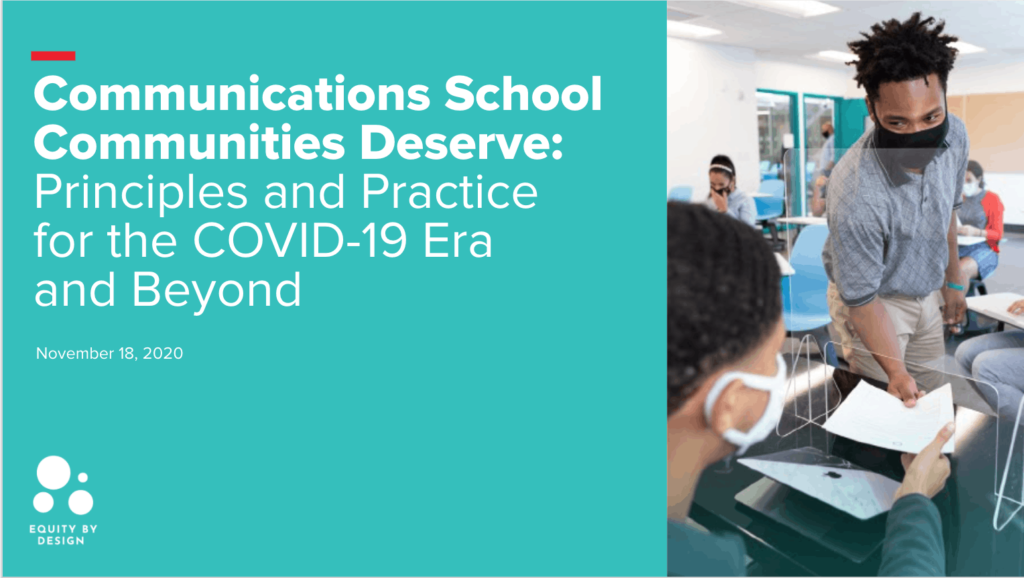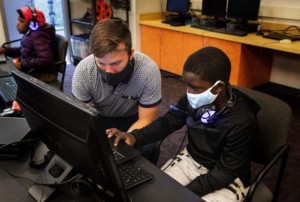Five Principles to Help Provide Our School Communities With the Communications They Deserve

By: Jonathan Flynn, Cecile Kidd, Aaron Daly and Eric Tucker
This past summer, as we prepared to safely reopen our Brooklyn LAB campus for in-person learning, we invited our school community to a virtual town hall to share insights from an 80-page document outlining our new COVID-19 health and safety protocols. Our team had devoted months to preparing and fine-tuning the work, and we were proud of our effort. But we didn’t get the reception we hoped for: The negative feedback from our families demonstrated we had missed the mark, and the reason was a failure in communications.
We had asked for and incorporated feedback from parents, staff, students, and experts on technical issues such as how to arrange furniture for a socially distanced classroom. But in subsequent, sometimes painful conversations, these same people revealed that we had failed to understand the more human aspects of a safe and healthy return, including what it would feel like to wear masks, maintain social distance, and prioritize hand hygiene.
We share this humbling experience because it contains an important lesson: As school leaders, we have too often failed to communicate well and collaborate with our communities. Our educators, students, and families deserve better. This is especially true this year, as we see the harm that multiple overlapping challenges—the COVID-19 outbreak, an economic downturn, and ongoing systemic racism—are inflicting on our students’ health, well-being, and educational progress.
Educators, students, and families have made tremendous sacrifices and done an incredible job during this extraordinary year. However, schools throughout the country, including Brooklyn LAB, have still fallen short on promises to communicate effectively about and with our communities on issues from the COVID-19 pandemic to the ongoing fight against racism.
To address this challenge, Brooklyn LAB partnered with McPherson Strategies, a communications consultancy, to understand what matters, what works, and what doesn’t work in school communications. We sought guidance from over 50 people from more than 25 organizations, including communications experts, child development experts, learning science specialists, school leaders, teachers, and school community members from the Educating All Learners Alliance (EALA).
Together, we created the COVID-19 School Communications Toolkit, organized around five core principles that represent the communications our school communities deserve. Within each principle, we include practical recommendations school leaders can apply now to communicate better during the COVID-19 pandemic and beyond. The guide also discusses how to use communications to address ongoing, deeply ingrained systemic challenges like racism and able-ism. Together, these principles and practices will help you establish new norms and a school culture centered around equity so that every student at your school can learn and thrive.
The Five Principles
Collaborative
The idea that “we’re better together” has helped schools prioritize the needs of the most vulnerable people during the pandemic. Schools can extend this ethos by communicating with their community, not just to their community. To practice collaborative communications, school leaders should focus on three things:
- Seeking input and buy-in.
- Creating multiple channels of open communication.
- Collaborating with external experts for counsel and accountability.
Empathetic
This year has been challenging, and recovery will take years after the pandemic ends. By consciously cultivating empathy, we can better understand and respond to the needs of our school community. Over the long term, this will help people heal. There are three main practices to embrace empathetic communications:
- Know your people.
- Be human.
- Hold space for racial justice.
Transparent and Truthful
In a period marked by pain and uncertainty—where truth and science have been denigrated—schools must embrace frequent, open, and fact-based communication. This can help schools build trust and combat misinformation that harms communities. Here are three ways to practice transparent and truthful communications:
- Elevate the facts.
- Give insight into the process.
- Update in real time.
Accessible and Inclusive
Everyone in the school community deserves to receive information in a way that works for them. The substance of messages, presentation, and method of delivery must be accessible to everyone. Historically, schools assumed that communications were sufficient as long as they reached most students, but working to ensure you reach every student will help your school build a more equitable community. Four practices will help you do this:
- Lead with equity and inclusion.
- Be consistent.
- Make it digestible.
- Address systemic racism head-on.
Resilient
There’s no need to sugarcoat the fact that school communities are experiencing grim realities. But you can use communications to help your community heal, look to the future, and highlight what is working. Centering communication around resilience can help mitigate families’ feelings of isolation, hopelessness, and distrust. There are three ways to practice resilient communications:
- Focus on what we can do.
- Highlight the community’s resiliency and cultivate a culture of mutual support.
- Open the door for long-term change.
Changing Our Communications to Improve Our Schools
We know we are not alone in our failure fully to honor the values and needs of our school communities through effective communications. National conversations about how to safely and effectively educate students during the pandemic have been polarized and unproductive. Moreover, the health crisis and the nationwide reckoning with racial injustice and police brutality have laid bare a longstanding truth about the U.S. education system: It continues to fail our most vulnerable students.
The problems are complex. But we believe that ineffective communication between school leadership and families is at its root. Even before the pandemic, school approaches to communications have been top down, one-way, and narrowly focused on the “average” students and families who are generally doing just fine. Schools and their leaders lack both the structures and the skills to listen deeply, converse constructively, and problem-solve collaboratively. As a result, we do not know, nor can we fulfill, the needs of those who have been marginalized by our system of education—especially Black, Indigenous, and people of color (BIPOC) communities, people who experience economic hardship, and people who live with disabilities. Without seeking and including their input in the process, we perpetuate a system that is designed to fail and exclude them.
To move forward together, we need to reimagine how school leaders and school communities engage with each other, and these five principles give us the foundation to begin this important work. Our school communities, and our country, deserve the chance to turn over a new leaf and begin a new approach to communication during the pandemic—and beyond.
For more, see:
- Engage Equitably Helps Education Leaders Communicate More Effectively with Families and Communities
- Podcast: Eric Tucker on Reopening Schools with Equity in Mind
- Preparing for a Healthy and Safe Return to School: Public School Facilities Planning in the Era of COVID-19
- Educating All Learners Alliance Launches Flagship Site, Shares Personas Educators Can Use to Understand Students’ Lived Experience During COVID-19
- Schools Need a Success Coach for Every Learner
- Preparing to Reopen: Six Principles That Put Equity at the Core
- To Reopen, America Needs Laboratory Schools
- How to Reopen Schools: A 10-Point Plan Putting Equity at the Center
- Reopening Schools: A Scheduling Map for Educators to Plan the Who, What, When, Where, and How of Learning this Fall
- The Front Porch: A New Approach to Support the Health, Safety, and Well-Being of Our School Communities
- Safeguarding Back to School: Preparation for a Healthy Return to School in Downtown Brooklyn
Jonathan Flynn is the Manager of Family and Community Affairs at Brooklyn Laboratory Charter Schools
Cecile Kidd is the Bursar at Brooklyn Laboratory Charter Schools
Aaron Daly is the Chief Operating Officer at Brooklyn Laboratory Charter Schools
Stay in-the-know with innovations in learning by signing up for the weekly Smart Update.
We know that educators and leaders have spent the last couple of months scrambling to meet the immediate needs of learners in their community. Thank you to each and every one of you for everything you’ve done to make the best out of this challenging situation. Now that the end of the school year is here, we’re shifting our Getting Through series from stories and advice to support remote learning or long term closures, to getting ready for the complex work of reopening schools this fall.
Interested in contributing to this campaign? Email your stories and ideas to [email protected] or tweet using #GettingThrough to participate!








0 Comments
Leave a Comment
Your email address will not be published. All fields are required.